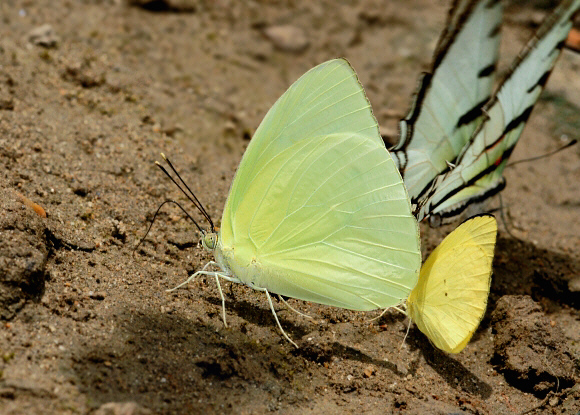
Introduction
There are 8 species in the genus Aphrissa.
On the upperside the male of statira is deep yellow at the base of the wings, with the outer third of both wings being a much paler greenish yellow. The female is a unicolorous lemon yellow, with a black spot in the fw discal cell, black wing margins and a black apex. The underside of the wings in both sexes has a lustrous appearance.
Aphrissa statira is by far the most widely distributed and abundant species. It is found from Florida to Bolivia.
Habitats
This butterfly is usually seen along riverbanks and other open habitats, at altitudes between about 0-1600m. It is commonest between about 200-800m.
Lifecycle
The eggs are laid singly on the leaves of the larval foodplants.
The caterpillars use a variety of hostplants including Cassia, Dalbergia and Entada (Leguminosae), Callichamys (Bignoniaceae) and Calliandra (Mimosaceae). DeVries considers that there may be two separate species under the name statira, as there are 2 larval forms which use host plants. The form which feeds on Leguminosae is orange, tinged with greenish, and has a dark bluish band below the spiracles, and an orange head. The form that feeds on Bignoniaceae has a green head and a pale green body with a thin yellow lateral stripe.
The chrysalis (Jamaican form) varies in colour from grey to pale bluish-green, and has a thin reddish line along the back and a cream lateral line.
Adult behaviour
The butterfly is strongly migratory in behaviour, flying upriver in the latter part of the dry season, and downriver towards the sea in the wet season. It often continues out onto the open sea and colonises islands e.g. in the Antilles. The flight is fast and direct, as is typical of migratory species.
Males are commonly found in groups, imbibing moisture from damp sand on river beaches. These groups are often tightly packed, with up to 100 butterflies crammed together on a square foot or less of ground. The butterflies sometimes form exclusive groups, but just as frequently intermingle with other pale coloured genera including Rhabdodryas, Phoebis and Protesilaus.
Females do not visit sandbanks, but can be seen nectaring at flowers, and are particularly attracted to red or orange flowers such as Lantana.
